🔥 Whitespark's Local Ranking Grids are coming soon! Get notified when we launch
🔥 Whitespark's Local Ranking Grids are coming soon! Get notified when we launch

When it comes to rank tracking, the data is often misunderstood. A very common concern amongst business owners is, “I checked my rankings and see different results than my rank tracking report. Your tool is inaccurate.”
In this Whitespark Weekly episode, Darren discusses this common concern and breaks down the top 4 factors that impact ranking results. If you’ve ever struggled with seeing different results or fluctuations in your ranking campaigns, don’t miss the video below.
Hey there, Darren here from Whitespark. Have you ever looked at the results in your rank tracking software and then compared them with your own manual search results, and wondered why they’re different? In today’s video, I’m gonna explain to you why that happens and why you don’t need to worry about it.
Today I want to address two common concerns that come up with rank tracking software:
I want to help you understand how rank tracking works, so you can understand how these ranking variations and fluctuations are actually expected behaviour, and not something to worry about.
First off, let’s discuss why you are typically going to see different results than what rank tracking software is going to report. 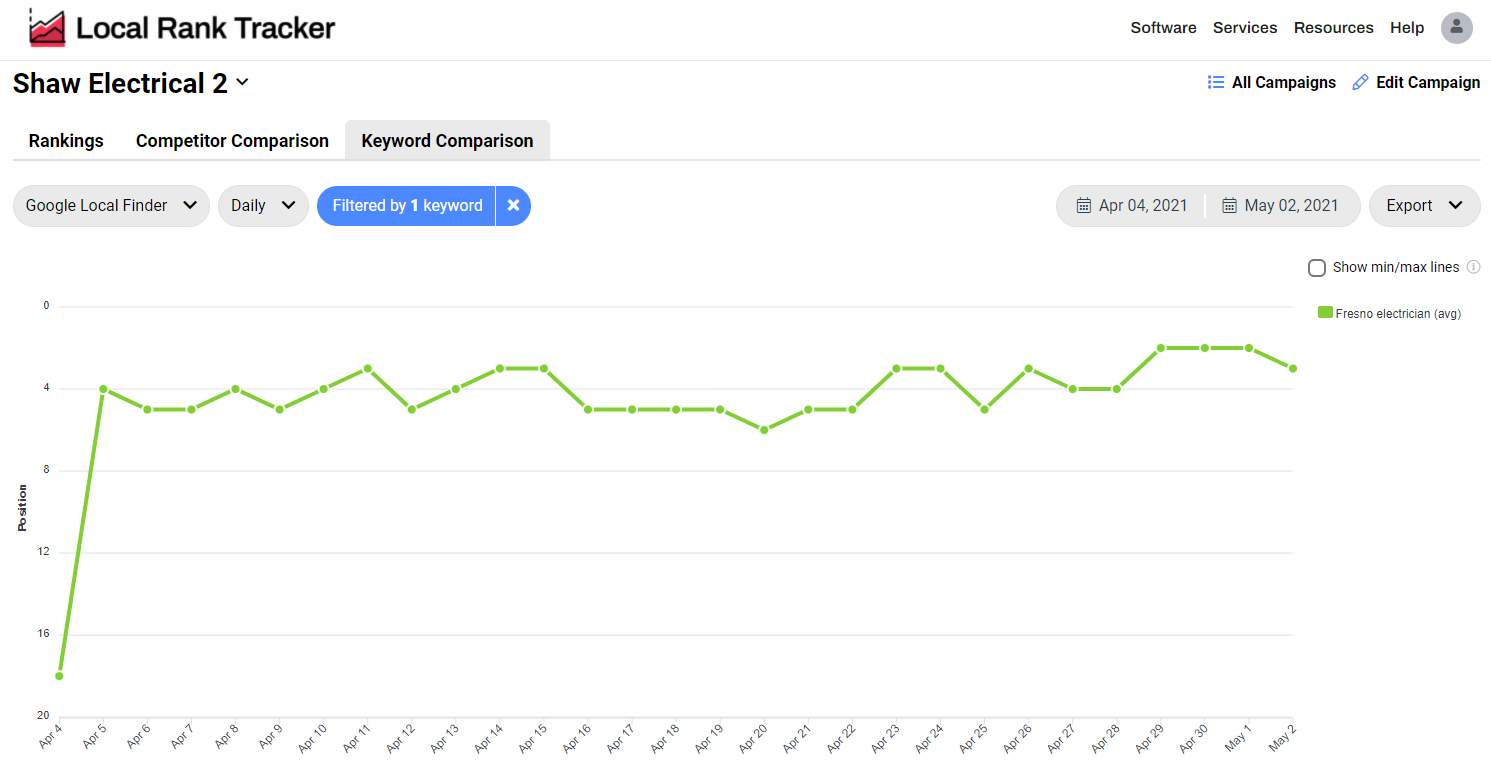 If I’m looking at my results, like in this case here, I can see that the rank tracking software (this is from our Local Rank Tracker) is reporting that for the term ‘Fresno electrician’ I’m typically ranking between 3 and 5. It jumps around a little bit, but I’m generally ranking in positions 5 to 3. I might see that in my software and think that doesn’t really jive with what I see in the search results.
If I’m looking at my results, like in this case here, I can see that the rank tracking software (this is from our Local Rank Tracker) is reporting that for the term ‘Fresno electrician’ I’m typically ranking between 3 and 5. It jumps around a little bit, but I’m generally ranking in positions 5 to 3. I might see that in my software and think that doesn’t really jive with what I see in the search results.
If I go to my search results, and I type in ‘Fresno electrician’…. Alright, well, Shaw Electrical is not in the top three. Where do I find my business? Here it is, what that’s like position 12. This rank tracker is not accurate. 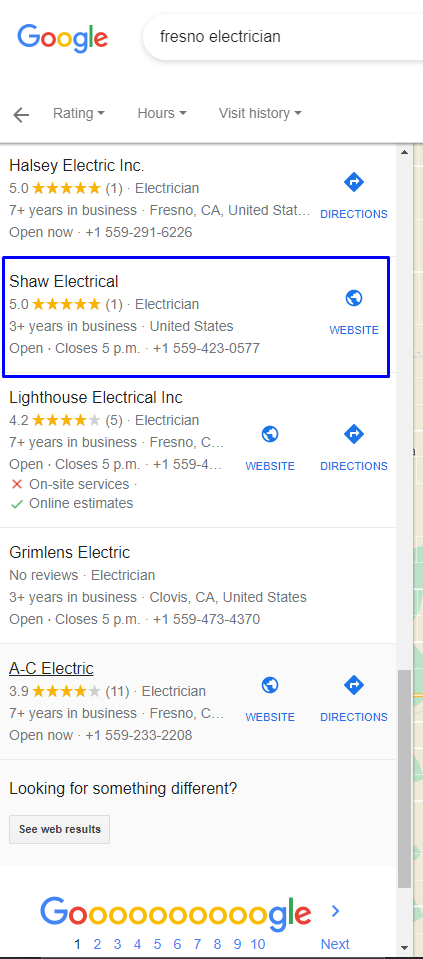 So that’s often what people will think. But that’s not how it works. Rank tracking is actually very complicated and Google search results are very complicated. You can’t really do a manual check like that. This applies to both the organic and the local rankings, but in the local rankings, you’re going to see an even more pronounced variation. Because of the strong impact that proximity plays in the local rankings. The thing is that there is no single accurate ranking that you can use as a metric. When you compare manually with what you see in the software, you’re almost guaranteed to always see different results. It’s expected behaviour.
So that’s often what people will think. But that’s not how it works. Rank tracking is actually very complicated and Google search results are very complicated. You can’t really do a manual check like that. This applies to both the organic and the local rankings, but in the local rankings, you’re going to see an even more pronounced variation. Because of the strong impact that proximity plays in the local rankings. The thing is that there is no single accurate ranking that you can use as a metric. When you compare manually with what you see in the software, you’re almost guaranteed to always see different results. It’s expected behaviour.
The reasons for this is that rankings vary significantly based on a number of different factors:
With regards to location, did you know that your rankings can vary on every single street corner? I wanted to test this so on a recent trip to the grocery store, I stopped every couple blocks, ran a search on my phone and took a screenshot. I specifically looked at the local pack to see how the rankings varied based on my physical location. 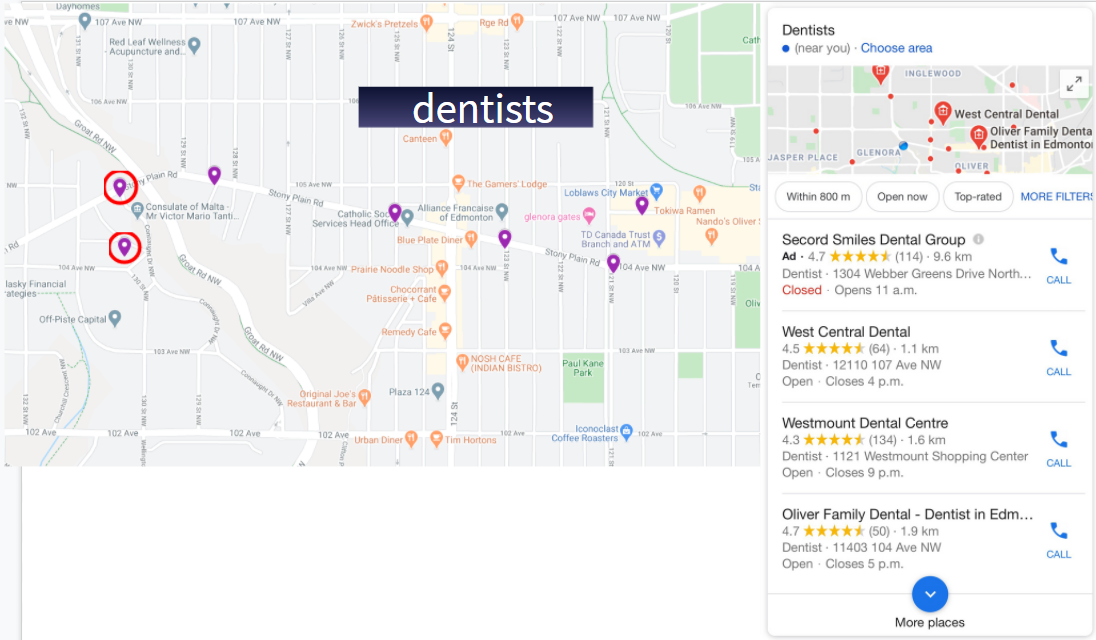
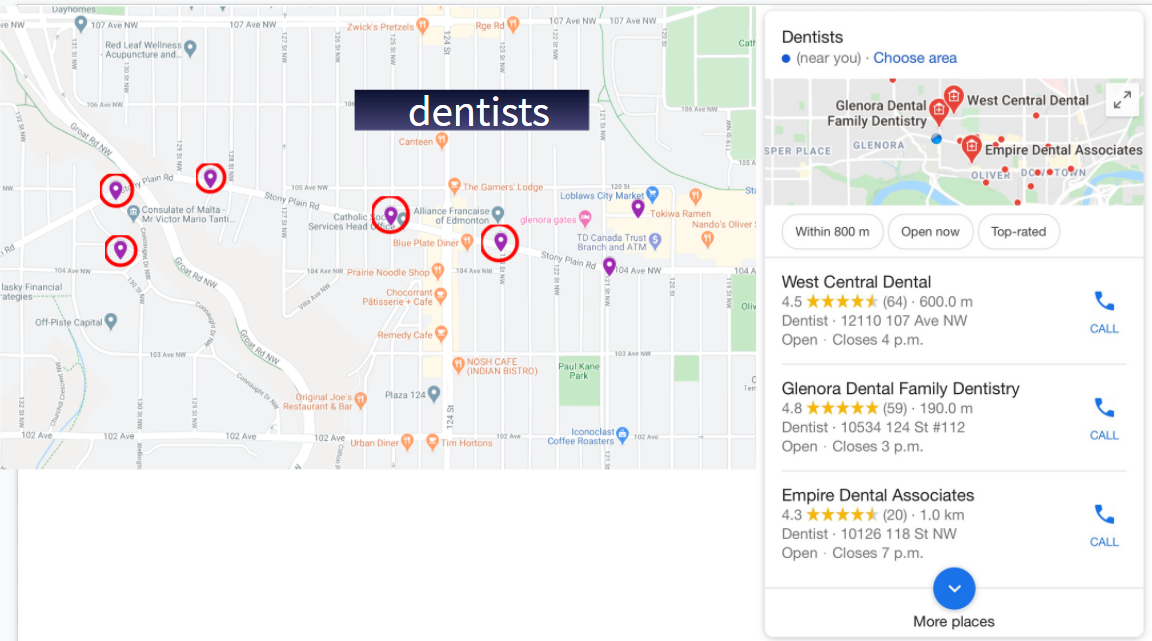
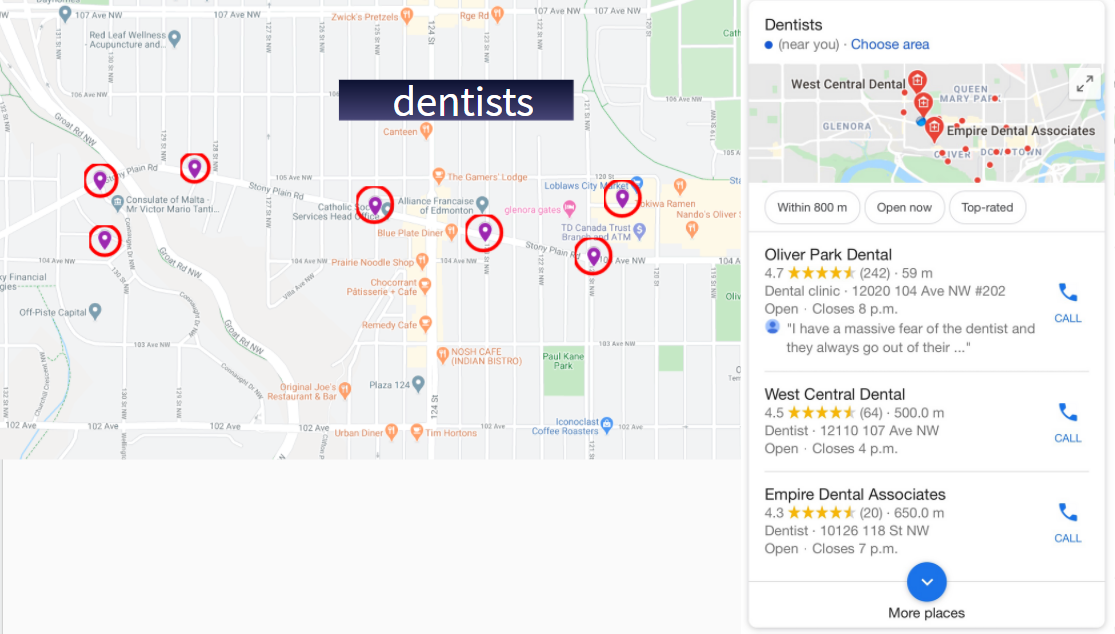 I’ve recorded the results so you can see how this works. This is what the local pack looks like at my location. I’ve got these three businesses ranking, if I go one block up, it’s still the same results, I still see the same three businesses ranking. One block over I can see that ‘Oliver Family Dental’ has dropped out of the local pack. Now there’s a new business in there, ‘Cindy Neufield’, then I go one block over and now two new businesses are in the local pack. This is just a two-block difference and my local pack has changed completely. I go another block and I get different businesses. You can actually see block by block, how the local results are changing. It’s pretty phenomenal what an impact proximity has on the local search results.
I’ve recorded the results so you can see how this works. This is what the local pack looks like at my location. I’ve got these three businesses ranking, if I go one block up, it’s still the same results, I still see the same three businesses ranking. One block over I can see that ‘Oliver Family Dental’ has dropped out of the local pack. Now there’s a new business in there, ‘Cindy Neufield’, then I go one block over and now two new businesses are in the local pack. This is just a two-block difference and my local pack has changed completely. I go another block and I get different businesses. You can actually see block by block, how the local results are changing. It’s pretty phenomenal what an impact proximity has on the local search results.
I think it’s important to understand how a rank tracker sets location. Rank trackers will use a special parameter called a UULE (Universally Unique Location Emulator) and that is a parameter you can pass to Google to say, ignore my device location settings, my GPS location settings, whatever, ignore those and set the location to be this precise spot. You can actually set them to be based off of the city and state, you can set a UULE based off of the zip code or even as precise as geo coordinate.
Let me show you how that works in action if I run a search for “plumbers.” Google knows I’m located in Edmonton and it’s going to give me a three pack. It’s definitely more precise than that. These businesses are actually all pretty close to my neighbourhood. You can see that this map is centered right around where I’m currently located. 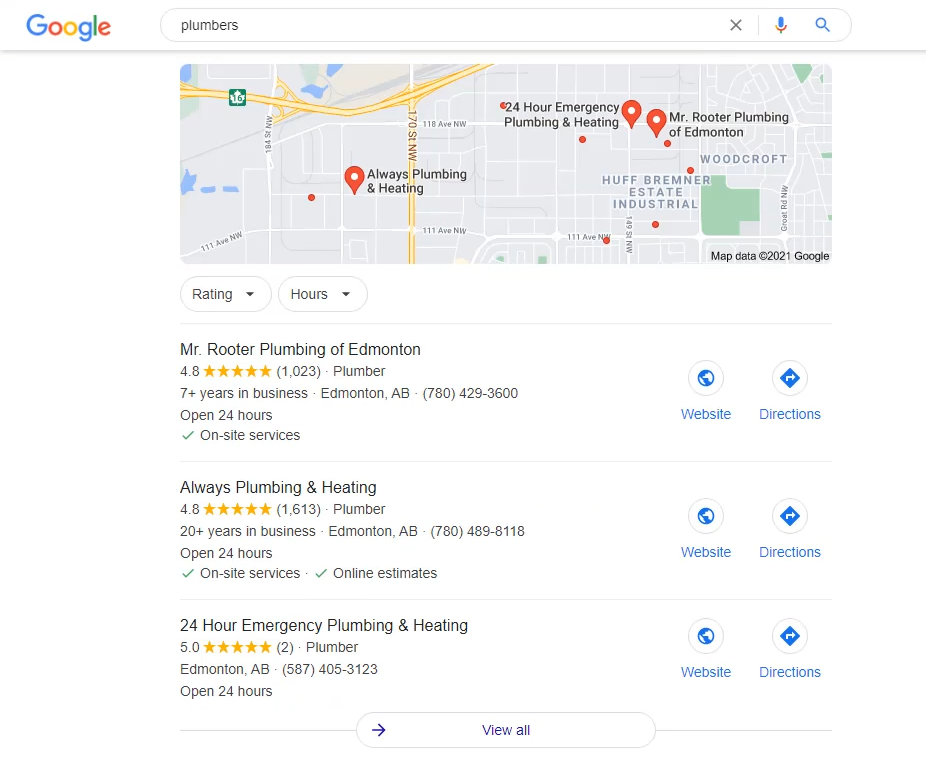 The way a rank tracker works is it tries to mimic that location setting, so we use UULEs to set the location. I’ve got a few of them recorded here. Let’s just say I want to set my location to Dallas. So if I take this UULE…
The way a rank tracker works is it tries to mimic that location setting, so we use UULEs to set the location. I’ve got a few of them recorded here. Let’s just say I want to set my location to Dallas. So if I take this UULE…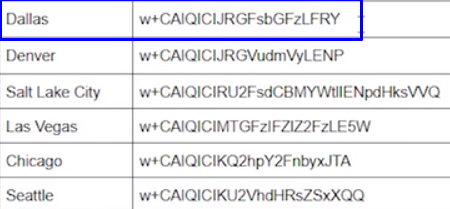 Instead of the location being set to my default location, I can actually add this parameter to the URL at the top here, I can say ‘UULE= [special code]’.
Instead of the location being set to my default location, I can actually add this parameter to the URL at the top here, I can say ‘UULE= [special code]’. That’s the location for Dallas. There we go. It set the location in Dallas and now I’m actually seeing a local pack for Dallas. That is how almost every rank tracking software works to specify the location and Google’s now going to show me results for that area. And it actually impacts all of the organic results and the local results.
That’s the location for Dallas. There we go. It set the location in Dallas and now I’m actually seeing a local pack for Dallas. That is how almost every rank tracking software works to specify the location and Google’s now going to show me results for that area. And it actually impacts all of the organic results and the local results.
Because rank trackers set location that way, unless you are manually setting location in the exact same way, it’s very hard to compare, you’re basically comparing apples to oranges, because your location setting is based off of your current location, whereas the software is being extremely precise about the location setting.
So it’s really important to understand that you can’t really mimic that location setting that the software is doing.Get the Local Rank Tracker that Local SEOs use. Track what matters and see the impact of your SEO work with our rank tracking software.
Another factor that comes into play is time because rankings will vary hour by hour. Chris Greene ran a really cool study on this back in 2017, he wanted to see how much fluctuation there in in the rankings, hour by hour. So they ran the exact same keyword, and they checked rankings. This chart here demonstrates how rankings jumped around. And you can see that each row represents a business or a URL, and you can see how it changed. ![]() I wanted to see if we had the same kind of impact in local rankings. So we ran a similar study at Whitespark, where we checked local rankings for a number of terms, hour by hour. Here’s one of the example charts from ‘Los Angeles pest control’. You can see the same kind of thing, some businesses aren’t ranking at all. Then they have this big spike, they start ranking in position 30, and then they drop off the face of the map again. Other businesses, they’re ranking in like position 60, they’ll jump up to position 30 and jump back down.
I wanted to see if we had the same kind of impact in local rankings. So we ran a similar study at Whitespark, where we checked local rankings for a number of terms, hour by hour. Here’s one of the example charts from ‘Los Angeles pest control’. You can see the same kind of thing, some businesses aren’t ranking at all. Then they have this big spike, they start ranking in position 30, and then they drop off the face of the map again. Other businesses, they’re ranking in like position 60, they’ll jump up to position 30 and jump back down. 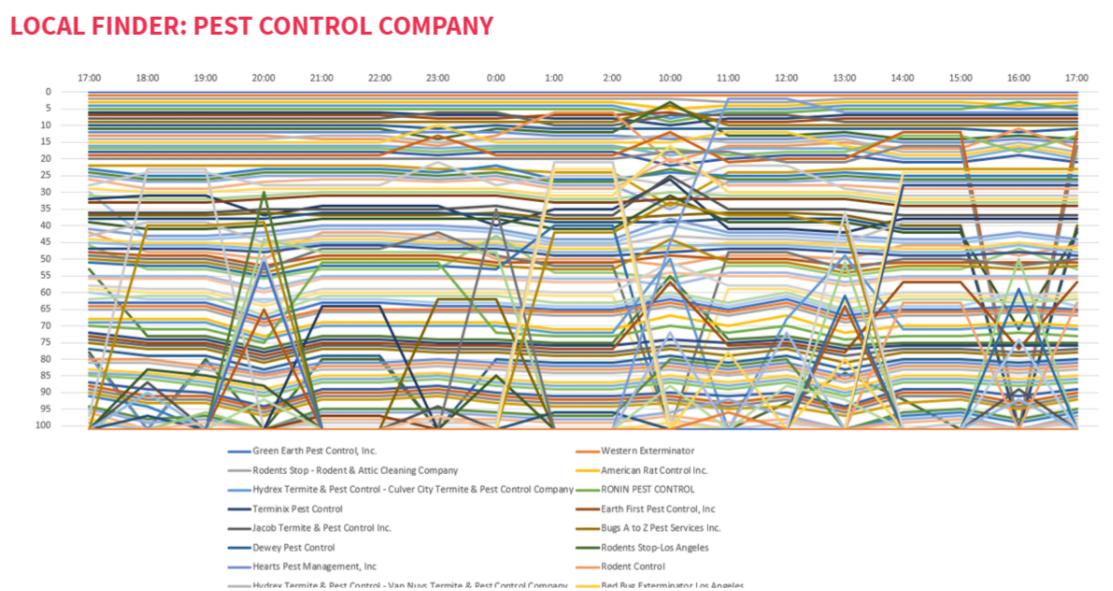 This is just on an hourly basis. And so what that means is, it’s very hard for you to assess the accuracy of the rank tracker by checking manually at, let’s say, 3 p.m., when the rank tracker ran at 2 a.m. If the rank tracker was crawling results a long time ago, and you’re checking now, the results could be completely different. So time is another factor, you have to consider.
This is just on an hourly basis. And so what that means is, it’s very hard for you to assess the accuracy of the rank tracker by checking manually at, let’s say, 3 p.m., when the rank tracker ran at 2 a.m. If the rank tracker was crawling results a long time ago, and you’re checking now, the results could be completely different. So time is another factor, you have to consider.
Another factor is just your IP address, because the rank tracking software is going to be searching from their server’s IP and your IP is going to show different results because of location, and any browser history that’s run on both of those IPs. Browser history will also impact the results.
Finally, there’s even variation between different browsers. If you run the exact same search right now for a term in Google Chrome, and then you run it also in Firefox, you’re going to see that the results are actually different – just slightly. Knowing that there’s so many different signals that Google is incorporating and how they change results, makes it pretty clear that it’s very hard to validate the accuracy of a local rank tracker. It doesn’t mean that the rank tracker is not accurate, the rank tracking software is accurate at that specific moment, with those specific location settings, you just can’t exactly mirror to validate. And no, you can’t set an incognito browser and turn off your location settings to mirror it. Because of all the reasons I just explained. There’s just too many other factors that you’re not able to mimic. So knowing that this variation exists, and knowing that rankings fluctuate so much, it should give you some confidence that you don’t really need to panic when you see a big ranking drop. For example, if my business is ‘Action Muffler’, and I’m tracking the term ‘radiator repair’, I might see that on the 28th of April, I was ranking in position 6 and then the next day, we totally plummeted. Now I rank in position 100. You know, sometimes if you’re an agency, you might get a phone call from a client saying – “Hey, what happened to my rankings, we totally fell off for radiator repair. I care about that term. I want to rank for it. Something’s gone wrong with the SEO. You have to fix it.”
So knowing that this variation exists, and knowing that rankings fluctuate so much, it should give you some confidence that you don’t really need to panic when you see a big ranking drop. For example, if my business is ‘Action Muffler’, and I’m tracking the term ‘radiator repair’, I might see that on the 28th of April, I was ranking in position 6 and then the next day, we totally plummeted. Now I rank in position 100. You know, sometimes if you’re an agency, you might get a phone call from a client saying – “Hey, what happened to my rankings, we totally fell off for radiator repair. I care about that term. I want to rank for it. Something’s gone wrong with the SEO. You have to fix it.” 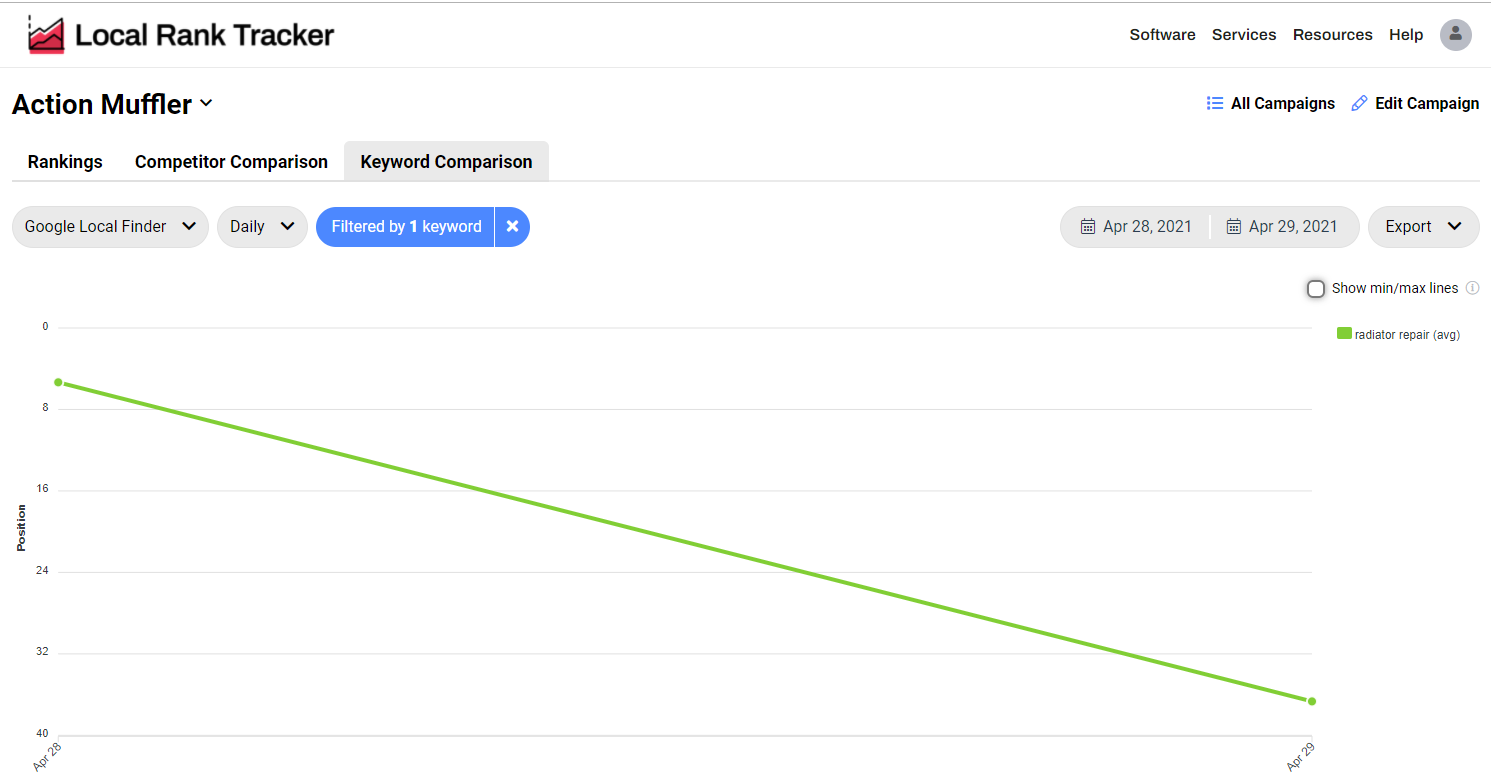 This is a case where I would say don’t panic. This is also expected behaviour. What you really want to be doing is analyzing your rankings as trends over time. So you can’t really look at, you know, point A to point B. You really have to look at the full trend. If you did zoom out and look at the full trend for this term, you would see a chart that looks like this.
This is a case where I would say don’t panic. This is also expected behaviour. What you really want to be doing is analyzing your rankings as trends over time. So you can’t really look at, you know, point A to point B. You really have to look at the full trend. If you did zoom out and look at the full trend for this term, you would see a chart that looks like this. 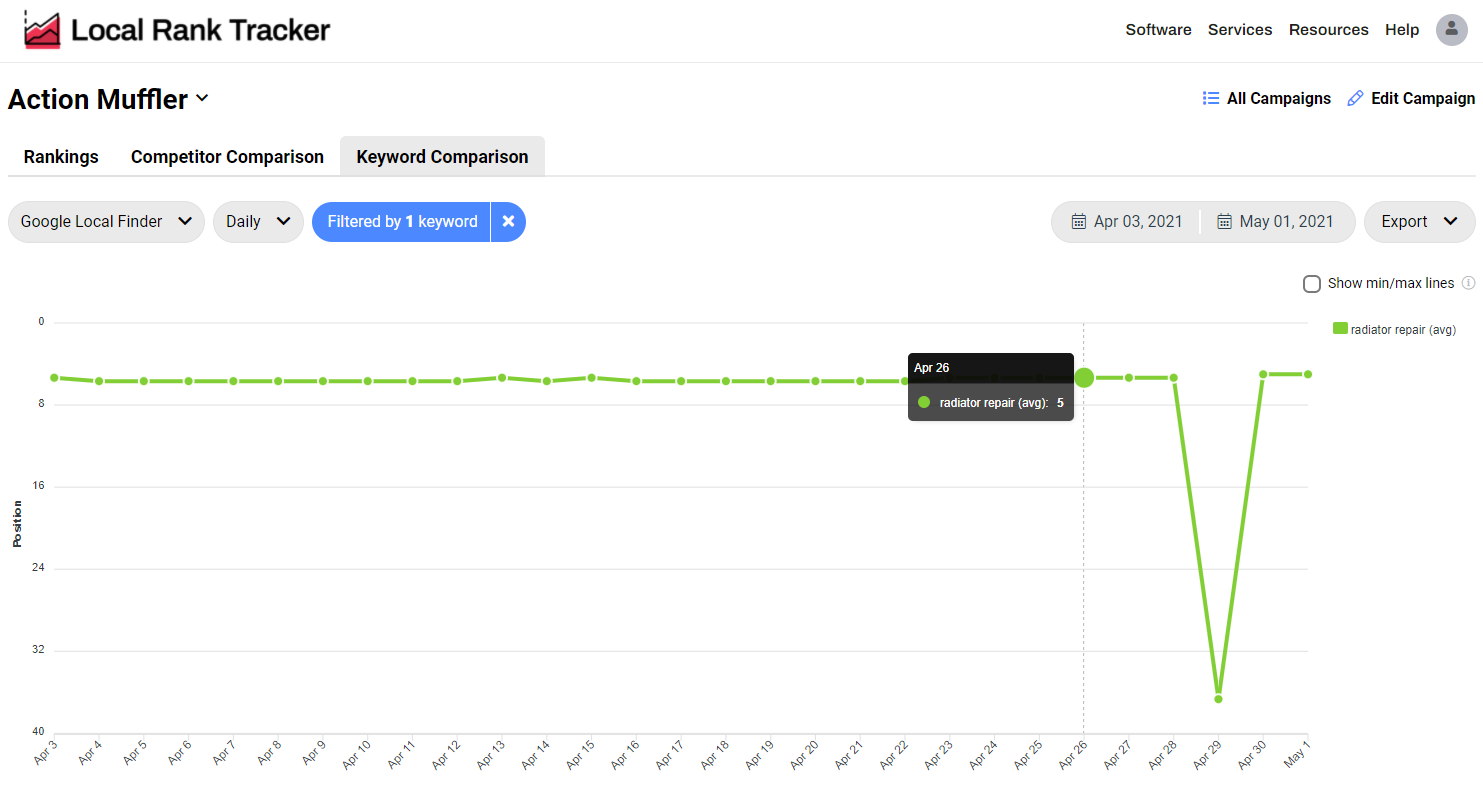 Basically, we rank in position 6-7 on average, almost every day. But at that precise moment in time, something wonky happened with Google. We actually fell down to 100. But the very next day, we were right back and rolling the way we were.
Basically, we rank in position 6-7 on average, almost every day. But at that precise moment in time, something wonky happened with Google. We actually fell down to 100. But the very next day, we were right back and rolling the way we were.
So you don’t need to panic when you see a drop like this, it doesn’t mean anything went wrong with your SEO. This is just Google being Google and it’s nothing to worry about.
This really makes you think about the frequency of rank tracking. So some people only track rankings monthly. If you track rankings monthly, you are really missing out on those trends. You need to see things over time because if you’re only tracking monthly, you might see that number and think – oh no, we totally fell off for that term, we better do something. You might mobilize the forces to try and get this thing fixed. But in reality, it’s not really a problem, you just happen to catch it at that little blip.
It’s really important to track rankings daily so that you can see the proper trends over time, and particularly in aggregate, across all your keywords. Start monitoring your trends in the Local Pack and Organic results, see what keywords are performing, and where your business needs to improve with Whitespark’s Local Rank Tracker – trusted and used by the industry’s top local SEOs.That leaves us with the question, should you even bother tracking rankings if you can’t validate the accuracy of the software? I would say that the software is accurate. It’s just you can’t mimic the exact results. But it helps you identify trends over time. That’s what’s really important. That’s why you really want to track rankings – what gets measured gets improved. It’s really important to track so you can identify problems and improvement opportunities.
Did you know that rankings vary by so many factors? Let us know in the comments below.